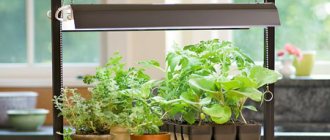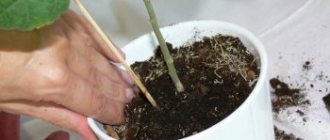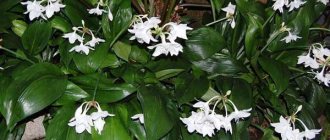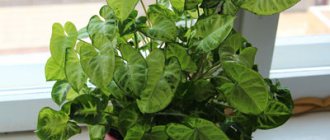How to choose a phytolamp for plants. 3 types of LED lamps - bicolor, multispectrum and full color. TABLE on the Top 15 lamps, compiled according to reviews of phytolamps (LED lamps for plants). + Self-test
TEST:
To test your knowledge of how to choose and install an LED phytolamp, take the test.
- What colors do plants need most?
a.Red and blue.
b.Green.
- How far away from the tops of plants should lamps be placed?
a.As close as possible.
b. At a height of 25-40 centimeters.
- How is the power of lamps selected?
a.50W/m²
b. Depends on growing conditions - from 40 to 150 W/m².
- What is the supply voltage for LED phytolamps?
a.220 volts.
b. In devices with a built-in power supply ~ 220V, and with an external = 12V.
Right answers:
- a – the maximum sensitivity of plants is located in the red and blue regions, and they reflect green, so the leaves are green;
- b – average distance from plants 25-40 centimeters;
- b – different plants in different conditions need different amounts of light;
- b - it depends on the design of the lamp - in devices with a built-in power supply ~ 220V, and with an external = 12V.
Test results:
- a, b, a, b - your knowledge is enough to independently select, install and connect LED phytolights;
- b, a, b, a - you do not have the knowledge to work independently;
- other options - you have knowledge, but it needs to be deepened by studying additional materials.
Plants need light to grow and develop. The best light is sunlight, but if it is not enough, then phytolamps are used. The best ones are LED. The best way to choose such lamps is to first study reviews of different models of such devices.
Phytolamps
We bought a phytolamp at the OBI store
There were different models, but I chose the largest and most expensive one. Not because he's so rich. It’s just that the larger the lamp, the higher its efficiency, the larger the area it can illuminate.
The box contained the lamp itself - an unexpectedly lightweight body with 225 LEDs on one side and mounts for hanging on the other. Despite the fact that all LEDs look exactly the same, they light up in different colors:
- 77 LEDs - red, for the flowering stage
- 77 diodes - orange, for the fruiting stage
- 47 LEDs - blue, for growth stage
- 24 diodes - white
The power cord caused some criticism. The lamp itself is not very heavy. If you hang it on the supplied metal cords, the cord significantly weighs down one side of the product, causing the lamp to hang at an angle. Is the electrical circuit really so complex and the energy consumption so significant that it was necessary to use such a massive cable? Surely something simpler, thinner and lighter would be suitable.
By the way, the power consumption of the phytolamp is only 14 watts. During operation, it practically does not heat up, so the minimum distance at which it is recommended to place the lamp from plants is 20 cm. The maximum distance is 1 meter. You understand that from such a distance only a small number of plants can be irradiated. If you want to illuminate a whole greenhouse, you will need several lamps... True, greenhouses are usually quite humid. Personally, we wouldn’t risk hanging the product there.
The lamp service life declared by the manufacturer is at least 40,000 hours. In other words, if you turn it on for 6 hours a day, the resource will last for 18 years. But this is if you use it every day. You can, of course, illuminate not only seedlings in the spring with a phytolamp, but also ordinary plants. True, for this they will have to be placed somewhere in one place. On the other hand, won’t they go crazy if such an “eternal summer” begins?
If you use the lamp only in the spring to support the growth of seedlings for beds and greenhouses, say, 3 months a year, then the lamp will fail after 74 years! Looks very optimistic. It remains only to confirm this experimentally. Let's see what happens to the product in at least 10 years. I will publish reports periodically.
Description of 2 and multi-color LED phytolamps
A phytolight is a lamp designed to illuminate plants when there is little or no natural light. It can be monochrome, 2 or multi-color, with the addition of white and ultraviolet.
Look in the picture at the spectrum of light needed by plants. During different periods of growth, plants need light of different colors. The most commonly used are red and blue, and in more expensive models white and ultraviolet. Phytolamps provide lighting with the required spectral composition and brightness.
These lamps use LEDs of different colors as a light source. The color ratio is adjusted by reducing the brightness or turning off unnecessary light sources.
Power is supplied from a ~220V network or an external power source =12V.
If necessary, such a lamp is made from scrap materials and LEDs or LED strips of the required colors - red, 630 nM, and blue, 465 nM. These values are close to the 660 and 445 nM used in factory designs.
It is allowed to use RGB strips and LEDs without connecting the green light.
Growth graph from light spectrum
The whole truth about LED phytolamps - 3 advantages and 1 disadvantage
LED phytolamps have advantages over other types of lamps:
- LEDs emit light, but, unlike other types of lamps, they do not heat up and do not warm the plants located under them;
- arranged evenly above the pots or collected in panels, which prevents the flowers from tilting towards the light;
- This is the most economical and durable light source.
The only drawback is the higher price, but it pays off due to energy savings and is gradually decreasing.
LED phytolamps for 2 types of aquariums – freshwater and marine
Look in the picture at the aquarium illuminated by phytolamps. There are also plants (algae) here and they are different in fresh and sea water.
In a freshwater body of water, algae require red and blue colors in a ratio of 5:1. In the sea, salt water absorbs red light, so the deeper the home of the aquarium's inhabitants, the bluer the illumination.
The inhabitants of the aquarium are better influenced by brighter light 8-10 hours a day than weak light 14-16 hours. The origin of most aquarium algae and corals is the tropics, where daylight hours last 12 hours, the period of photosynthesis is no more than 10, and long-term illumination provokes the development of lower algae.
According to the observations of Western aquarists, a decrease in illumination during the day by 1-2 hours has a positive effect on the processes occurring in plants.
The recommended average power of LED lamps is from 0.1-0.3 W/l in aquariums without algae to 0.8 W/l and higher in “Dutch” aquariums with lush vegetation.
LEDs for aquariums
LED spectrum length for plants
It has been established that biological processes occurring in plants require a certain length of light waves. Figure 1 provides a graph demonstrating this relationship.
Dependence of plant sensitivity on a specific spectrum
Designations:
- A – graph of the dependence of chlorophyll synthesis;
- B – photosynthesis;
- C – photomorphogenesis.
We see that plants absorb light waves with a length of 445 nM and 660 nM most intensely, falling in the blue and red parts of the spectrum. This is why conventional sources are not suitable for artificial lighting; you will need a phytolamp or phytolape. The most effective backlight, in which the ratio of blue and red light is 1 to 4-6.
LED phytolamps for phalaenopsis orchids – 2 types of lighting
Look in the picture at the phalaenopsis orchids illuminated by phytolights. Lamps must provide diffuse illumination, so one lamp is not enough, regardless of power. They are installed as close to the plants as possible (3-5cm). The choice of color depends on the task facing the plant owner.
Red light stimulates active flowering. To do this, it is enough to turn on the lamps for an hour twice a day, in the morning and in the evening.
Leaves grow in blue light. They should also be turned on in the morning and evening, in the dark, to extend the daylight hours of the plants.
Blue-colored lamps that produce almost no visible light are black lamps.
The best option is a combination of red and blue colors, for the growth of flowers and leaves, and white, which turns on when there is a lack of daylight.
There are two light distribution options:
- red and blue lamps shine simultaneously;
- A red lamp shines in the morning and evening, and a blue lamp during the day.
When there is insufficient natural light, the white light is turned on twice a day for an hour.
LED phytolamps for orchids
There was no phytolamp yet
Plants love light. Everyone knows this. If the windows of the house do not face the sunny side, then the seedlings turn out to be lethargic and grow poorly. At the same time, the neighbor, who lives in an apartment with windows on the other side, probably has taller and stronger seedlings. Unlike the one that grows on the dark side.
Sometimes it gets worse. The sun shines through some windows in the morning and through others in the afternoon. And so the pallets with seedlings wander around the rooms every day following the sun. Each transfer is a potential opportunity to drop them and break the newly hatched stems.
In spring, when it gets dark early, plants do not receive enough light and do not grow as quickly as we would like. They say that for normal development they need 12-16 hours of light a day. But where can you get them in March-April? There's not even a dozen here. That’s when the idea comes to mind to buy a philolamp and illuminate the plants with it for several hours, when the sun is already below the horizon.
While she was away, my wife moved pallets of seedlings twice a day.
Do-it-yourself phytolamp for plants - 4 stages of assembly
Look at the picture at the homemade phytolamp. If necessary, it is made by hand. Such a product will not be as beautiful as a factory-made one, but it will be much cheaper, and it will help plants grow almost as well.
For manufacturing you will need the following materials:
- LEDs. In such designs, special LEDs are used for phytolamps or super-bright ones installed on the radiator. Instead, you can use a large number of low-power tapes of appropriate colors (630 and 465 nM) or RGB tapes.
- Base or radiator. When using aluminum or steel strip, these elements are combined.
- Power supply. This is a special driver, dimmable power supplies for each color or one unit and switches for groups of LEDs. The power should correspond to the power of the lamps and 20% reserve.
- Base. It uses a plastic box or a metal structure that can serve as a radiator. The size should match the length of the bed and not blind people on the street.
- Stand for fastening. It is advisable to provide height adjustment. Instead of a stand, it is allowed to hang the phyto-lamp from the ceiling.
- Installation wires. Copper strands are used, which are soldered to the LEDs.
The assembly order is as follows:
- Check elements for serviceability. The LEDs are checked by a tester, and the tape is checked by applying voltage.
- Attach light sources to the base. High-brightness LEDs are attached with bolts and thermal paste, and the tape is secured with an adhesive layer or double-sided tape.
- Connect the wires using soldering or connectors.
- Attach the base to the stand and adjust the height.
Do-it-yourself phytolamp for plants
Some time has passed
Surely you are already tired of reading lengthy discussions and are waiting for an answer to the main question: to buy or not to buy?
Instead of a direct answer, I'll show you a couple of pictures. This is what your window or table on the balcony will look like, where the seedlings and phytolamp are located. If there is a separate room, then everything is fine. But staying for a long time in a room that is illuminated with such a killer purple light is not an acquired taste:
As for plant benefits, look at these two tomato plants. Surely you can guess which of them was illuminated every evening with a phytolamp, and which was in the “control group” and grew in natural light on the windowsill of another room:
Draw conclusions. I do not “promote” my purchase in any way. The purchased phytolamp, like the OBI store itself, is nothing to me. Why would I embellish something or, on the contrary, denigrate something? Here in the article are just facts.
The advantages are obvious - plants grow faster. The disadvantages are also obvious - the lilac light of the lamp begins to irritate over time. Fortunately, I have the opportunity to put all this gardening in a separate room and close the door. But using a phytolamp in a one-room apartment, in my opinion, is a dubious pleasure.
- Back
- Forward
LED phytolamp with g13 socket
Lamps designed for the use of fluorescent lamps with a standard G13 base are used as homemade phytolights. In such devices, instead of conventional ones, with minimal modification of the circuit, LED lamps, white or colored, of the same dimensions and shape are installed.
LED phytolamp with g13 socket
Phytolamp is a great gift for March 8
Many men are in a depressed and depressed mood on the eve of this wonderful spring holiday. What to give to your wife, mother or just a good friend on March 8th? If your women are interested in growing fruit plants, then they will certainly appreciate the gift. Prices for phytolamps vary. If you want to make one of your family members happy, you can buy a more expensive lamp. If this is just a routine offering, buy a cheaper herbal lamp. The one that screws into a regular base. In any case, such an unexpected and desirable gift for any gardener will certainly be appreciated.
As for me, that's exactly what I did. I presented my wife with a large LED phytolamp from the OBI store. However, you can buy them in other places. For example, order on Ozone.
Giving phytolamps is great! On the one hand, this is not an essential item, so the gardener himself most likely will not buy such a thing for himself. But if someone gave it... In a word, I gave you a tip, and you decide whether it’s worth doing this in your case.
Cheap LED phytolamps cash on delivery for seedlings – 2 countries to order
In order to save money when purchasing LED phytolights, they can be purchased with cash on delivery in online stores.
Reviews of Chinese LED phytolamps for plants from Aliexpress - 3 reasons to refuse the purchase
Cheap lamps are sold in China, on Aliexpress and other trading platforms. But with the rise in the dollar exchange rate, the price/quality ratio has worsened. Besides this, there are other reasons:
- The parameters do not match those specified. The lamp shines, but its brightness is checked only with a lux meter.
- No warranty. Theoretically, it is, but you will have to send the goods to the seller at your own expense and wait a long time for a return.
- Poor quality of LEDs, which manifests itself after a few months, when it is too late to refuse the product and demand a refund. This is due to the manufacturer’s desire to save on costs at the expense of quality.
Reviews about the seller should be treated with caution. Most shortcomings are not identified immediately, but after some time, when a positive assessment has already been given.
LED phytolamps for plants in Komsomolsk - 5 reasons to purchase in domestic stores
Purchasing equipment from manufacturers who have been supplying products to the domestic market for many years provides the best results:
- there are reviews about the product on the forums;
- companies value their reputation;
- It is possible to return the product free of charge and exchange it during the warranty period;
- the product has a quality certificate;
- The dollar exchange rate has increased and purchasing goods from domestic producers is more profitable than imported ones.
In Komsomolsk, LED phytolamps can be purchased in online stores, a list of which can be found through Yandex Market.
DIY phytolamp made from LEDs
Answers to 5 Frequently Asked Questions
There are questions that are asked when choosing phytolights:
- What should be the power of LED phytolamps?
The required power is determined after consultation with specialists or on specialized sites. Average values are 40W/m² on window sills, 80W/m² with artificial lighting and 150W/m² in growboxes. - What color LEDs are needed?
The most commonly used are red and blue, but in more expensive designs white and ultraviolet are added to them. - What is the color ratio?
The ratio of red and blue varies during different periods of the growing season, but the average ratio is 5:2, 7:3, or more simply, 2:1. - What is the supply voltage?
Factory-made lamps with a built-in power supply are connected to a ~220V network, assembled from LED strips =12V. - At what height are phytolights installed?
25-40 cm from the tops of plants.
Installation height of phytolights
Advantages of phytolents over other sources
Here are several factors that speak in favor of LED backlighting:
- lower consumption compared to halogen, mercury and luminescent phytosources;
- narrow spectral range guarantees maximum efficiency;
- low supply voltage increases the level of safety;
- high efficiency;
- less susceptible to heating than light bulbs, therefore, they can be placed closer to the plants, which allows the use of a source of lower intensity;
- do not contain substances that pose a health hazard.
Phyto-tape with a ratio of blue and red light of 1:5
Unfortunately, such a source has one significant drawback that limits its widespread use - high cost, so we will consider alternative options.
It is also important to know 3 nuances
There are 3 nuances taken into account when choosing a phytolight:
- too bright light is harmful, as is its lack, so the illumination should be checked with a lux meter or calculated based on the power of the lamps per unit area;
- plants are drawn to light, so it should be located evenly above them;
- the required distance to the plants is 25-40cm, so the lamp must be raised as they grow;
3 nuances taken into account when choosing a phytolight
How to avoid 3 mistakes
There are mistakes that inexperienced electricians make when choosing and installing LED phytolights:
- Incorrect color ratio. Different plants at different periods of growth need light of a different spectrum and it must be changed during the growing process.
- Insufficient power supply. It should exceed the power of LEDs by 20%.
- Install the lamps so that when watering they get water. This will lead to a short circuit and failure of the device.











